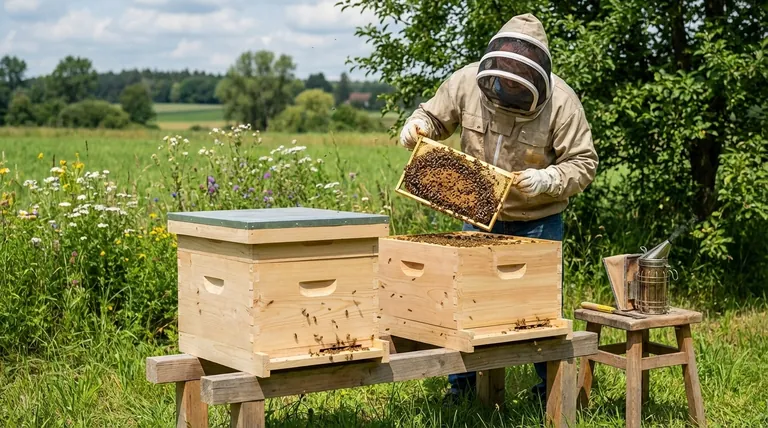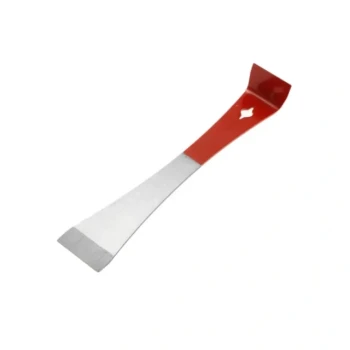For new beekeepers, starting with two hives instead of one is a foundational strategy recommended by experts. This approach is not about doubling your honey production from day one; it's about risk management, creating a support system for your bees, and dramatically accelerating your learning curve.
The core principle is this: managing two hives is not like having two independent pets, but rather like managing a small, interconnected system. This system provides its own insurance and resources, transforming potential colony-ending failures into solvable management challenges.

The Power of Comparison: Your Built-in Control Group
Having a second hive provides an immediate, real-time reference point. This is invaluable for a beginner who is still learning what "normal" looks like in the complex world of a bee colony.
Establishing a "Normal" Baseline
With a single hive, you have no context. Is the population growing slowly because of a poor queen, or is it just the normal pace for your local climate and nectar flow? Two hives, side-by-side, give you an instant comparison.
If one colony is building up rapidly while the other lags, you have a clear signal that something needs investigation.
Diagnosing Problems Faster
Comparison makes it easier to spot subtle issues. You might notice one hive is significantly more defensive, has a spotty brood pattern, or shows signs of pests like Varroa mites while the other appears healthy.
This direct contrast helps you identify problems early, well before they become catastrophic.
Accelerating Your Learning Curve
Observing two colonies simultaneously exposes you to twice the variability. You will learn faster about different colony temperaments, queen productivity, and foraging behaviors in one season than you would in two seasons with a single hive.
The Second Hive as a Resource Bank
The most powerful reason for having two hives is the ability to share resources between them. This turns a second hive into a "bank" of bees, brood, and food that can be used to solve common and often fatal problems.
Solving a Queenless Crisis
If a hive loses its queen—a common and devastating event—it is doomed without intervention. With only one hive, your only option is to buy a new queen, which isn't always possible or successful.
With a second, queen-right hive, you can simply move a frame containing fresh eggs and young larvae into the queenless hive. The bees will use these resources to raise their own new emergency queen, saving the colony.
Equalizing Colony Strength
It is common for one hive to be much stronger than the other. A very weak hive may not survive the winter, while a very strong hive may swarm, costing you half your bees.
You can "borrow" a frame of capped brood (developing bees) from the strong hive and give it to the weak one. This boosts the weak hive's population and slightly tempers the strong hive's urge to swarm, creating two healthy, stable colonies.
Sharing Food Stores
If one hive is low on honey or pollen stores heading into winter or during a nectar shortage, you can supplement it with a frame of honey from the stronger hive. This simple act can be the difference between survival and starvation.
Understanding the Trade-offs
While highly recommended, starting with two hives is not without its considerations. It's important to weigh the benefits against the practical realities.
The Initial Investment
The most obvious trade-off is cost. You will need to purchase two sets of bees (packages or nucs) and two complete hives (boxes, frames, foundations). This represents a significant upfront financial commitment.
The Increased Workload
Managing two hives requires more time for inspections and maintenance than managing one. However, most beekeepers find this extra time is also a valuable learning opportunity, reinforcing good habits and deepening their understanding.
The Risk of Disease Spread
When sharing frames between hives, you must be vigilant. If one hive has a disease, you can easily transfer it to the other. This requires careful inspection and good hive hygiene, such as cleaning your hive tool between inspections.
Making the Right Choice for Your First Season
Ultimately, the decision rests on your goals and tolerance for risk. The consensus among experienced beekeepers, however, is clear.
- If your primary focus is minimizing risk and maximizing learning: Starting with two hives is the undisputed best practice that dramatically increases your odds of success.
- If your primary focus is the lowest possible initial cost: A single hive is feasible, but you must accept a significantly higher risk of total failure and losing your entire investment in the first year.
- If you are considering more than two hives: This is generally discouraged for beginners, as the workload can quickly become overwhelming before you master the fundamentals.
Starting with two hives provides the resources and insight needed to navigate the challenges of your first year, setting you up for a more resilient and rewarding beekeeping journey.
Summary Table:
| Key Advantage | Benefit for the Beekeeper |
|---|---|
| Comparison & Diagnosis | Spot problems faster by comparing two hives side-by-side. |
| Resource Sharing | Use frames of bees, brood, or honey from one hive to support the other. |
| Queen Crisis Management | Save a queenless hive by providing eggs from your second colony. |
| Accelerated Learning | Gain experience with different colony behaviors and challenges in one season. |
Ready to start your beekeeping journey with confidence?
Starting with two hives is a foundational strategy for success, and having the right equipment is just as crucial. HONESTBEE supplies commercial apiaries and beekeeping equipment distributors with high-quality, durable beekeeping supplies through our wholesale-focused operations.
Let us equip you for a resilient and rewarding first season. Contact our experts today to discuss your hive setup and wholesale needs.
Visual Guide

Related Products
- Langstroth Bee Hives Bee Keeping Box for Beginners Beekeeping
- HONESTBEE Professional Long Handled Hive Tool with Precision Cutting Blade
- HONESTBEE Advanced Ergonomic Stainless Steel Hive Tool for Beekeeping
- Multi-Functional Sliding Hive Entrance for Beekeeping
- Long Langstroth Style Horizontal Top Bar Hive for Wholesale
People Also Ask
- What are the key features of the Langstroth beehive? A Guide to the Standard for Modern Beekeeping
- Why might a beginner be advised to start with a Langstroth hive? Unlock a Supportive Beekeeping Ecosystem
- Why were wooden hives traditionally preferred? For Natural Beekeeping Aligned with Bee Biology
- What is the best type of bee hive for beginners? Start with the Proven Langstroth Standard
- What basic equipment is needed to start beekeeping? Your Essential Guide to a Confident Start



















